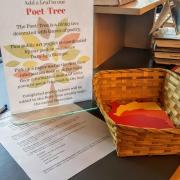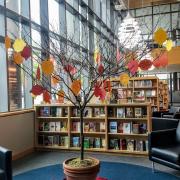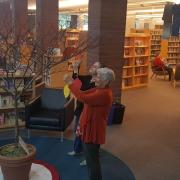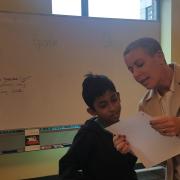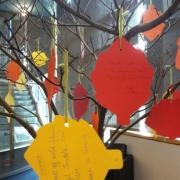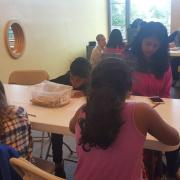Princeton Public Library was fortunate to have Dara-Lyn Shrager as our first poet-in-residence in fall 2018. One of our programs during this period was a "Poet-tree" art installation created by community members of all ages.
The program began with a weekend workshop exploring a variety of poetic forms. It was attended by children with their parents as well as some seniors and teens. The purpose of the workshop was to learn, have fun and get the art installation started by writing original poems on colorful paper leaves to be hung with yarn from a potted branch in our lobby to form the Poet-tree.
We placed the Poet-tree next to our Welcome Desk on the first floor. The art installation reversed nature’s fall seasonal progression, starting off bare and filling with leaves throughout October and November. We had baskets of leaves with instructions at each public service desk so patrons could add leaves at any time. After six weeks, we had more than 125 leaves of poetry, written by poets with an age range from 4 to 94.
Advanced Planning
We had to source a "tree" for hanging the poetry leaves. Quite a few options were considered; in the end, we were lucky enough to find a local landscaper who donated an appropriate tree and pot. The tree could also be an outline on a bulletin board or constructed from wood and be more representational than realistic. We also found some bare trees (both with and without twinkle lights) online that we considered purchasing.
We also had to figure out the size of the leaves, decide what type of poetic examples to use that would inspire without being daunting, write the instructions and get the word out.
The poet and two members of our programming team started planning about a month in advance. We decided to do a workshop to jumpstart the tree even though it was mostly intended as a passive program.
Our goal for this program was to get everyone excited about poetry and to create an art installation that involved the community in a visible way.
Marketing
Having the tree in a visible location was the best marketing. People were curious and wanted to know what was going on. We put the tree up about a week before the workshop and had fliers about the workshop next to it as well as information about the project.
After the workshop, we had posters at each desk with baskets of leaves and instructions on how to take part. One of our blog team members wrote a post encouraging everyone to contribute, and we did social media promotions as well.
Budgeting
The only cost for this project was the leaves for the tree and wool for hanging the leaves. We found packages of precut leaves in fall colors online and spent about $40 to purchase them and an additional $5 for appropriately colored wool. We could have cut them out from construction paper and saved money, but we knew we needed a large quantity and the price seemed worth it to save time and energy.
The tree was donated, but if you do not get a tree donated you might need to spend additional money.
By using the blog, social media and word of mouth, there was no cost for PR.
Day-of-event Activity
This was an ongoing passive activity for six weeks, so we needed to have baskets with leaves at each desk and instruction sheets ready for the start day. We did a kick-off workshop, but this is optional. One staff member did all the preparation and on the day of the workshop we had one staff member as well as the poet. No challenges were encountered.
The instructions read as follows:
We’d love to see the branches bursting with poems and invite you to add your own contribution. Pick up a paper leaf at either the Welcome or Youth Services Desk and unleash the poet within. Here are some tips to keep in mind:
- Remember, this is meant to be fun and voluntary, not a school or work assignment.
- Any kind of poem is welcome (and, anyone can write a poem!)
- Be creative! Add pictures or illustrations to your poem-on-a-leaf.
- Use both sides of the leaf for two poems or a poem and a drawing. (Hint: practice first to save leaves!)
- Return your leaf back to either the Youth Services or Welcome Desk. We add leaves on the poet-tree frequently.
People loved not only having a chance to have their poem displayed on the tree, but also having a chance to read the poems of others. We gathered several chairs around the base the of the tree so that people could read beneath it and enjoy the colorful, poetic installation.
Program Execution
We did the workshop in our STEAM studio with participants seated around large tables with lots of paper and supplies for writing. We had a handout and then used the white board to brainstorm about types of poems. The poet-in-residence talked about poetic forms such as haiku, quatrains, acrostic, etc. and the workshop participants wrote several poems on plain paper before deciding which ones to put on leaves.
Once the leaves of poetry were completed, we used a hole punch and wool to prepare them for hanging. At the end of the workshop all the participants hung their leaves on the tree as a group and read out loud their poems if they chose. Thirty-two people attended the workshop, and the feedback was very positive, especially from the parents who were thrilled to see their children writing poems. Many families wrote a poem together.
Our goal to get the tree started with some leaves of poetry was achieved. We had hoped for 20 participants for the workshop, so 32 exceeded our goal. We were pleasantly surprised to have some teens drop in for a bit and also to have several adults and seniors come on their own.
This was a successful program, and our goals of encouraging people to write poetry was met. Almost daily we got comments at our service desk about the Poet-Tree and how much people liked seeing it in the library or sitting beneath it to read a book. It was cheery and made our first floor welcoming.
The best part of all, though, was seeing the look of pride on a child's face their poem got hung on the tree. Seeing the tree fill over several weeks was very fulfilling for the staff and the community as a whole.
Advice
Programs like this are relatively simple, and there are many variations that could be done. We are now embarking on a snowflake-cutting community project using a similar method. People like to see their work on display in public places and there are simple and easy ways to make this happen.

